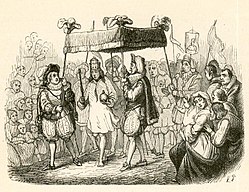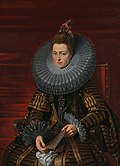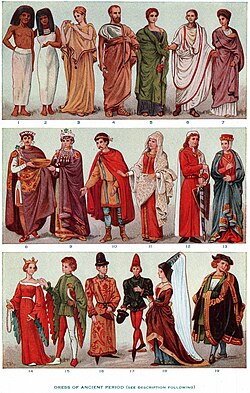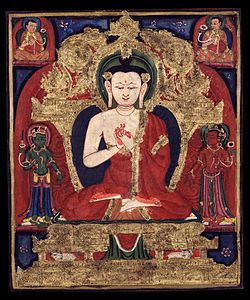Portal:Clothing
The Clothing Portal

Clothing (also known as clothes, garments, dress, apparel, or attire) is any item worn on a human body. Typically, clothing is made of fabrics or textiles, but over time it has included garments made from animal skin and other thin sheets of materials and natural products found in the environment, put together. The wearing of clothing is mostly restricted to human beings and is a feature of all human societies. The amount and type of clothing worn depends on gender, body type, social factors, and geographic considerations. Garments cover the body, footwear covers the feet, gloves cover the hands, while hats and headgear cover the head, and underwear covers the intimate parts.
Clothing has significant social factors as well. Wearing clothes is a variable social norm. It may connote modesty. Being deprived of clothing in front of others may be embarrassing. In many parts of the world, not wearing clothes in public so that genitals, breast, or buttocks are visible could be considered indecent exposure. Pubic area or genital coverage is the most frequently encountered minimum found cross-culturally and regardless of climate, implying social convention as the basis of customs. Clothing also may be used to communicate social status, wealth, group identity, and individualism. (Full article...)
Textile is an umbrella term that includes various fibre-based materials, including fibres, yarns, filaments, threads, and different types of fabric. At first, the word "textiles" only referred to woven fabrics. However, weaving is not the only manufacturing method, and many other methods were later developed to form textile structures based on their intended use. Knitting and non-woven are other popular types of fabric manufacturing. In the contemporary world, textiles satisfy the material needs for versatile applications, from simple daily clothing to bulletproof jackets, spacesuits, and doctor's gowns. (Full article...)
Textile arts are arts and crafts that use plant, animal, or synthetic fibers to construct practical or decorative objects. (Full article...)
Selected articles -
Did you know (auto generated)

- ... that Swertia japonica was used as an insecticide for clothes during the Edo period?
- ... that during the Second World War, the British government's campaign Make-Do and Mend encouraged the public to fashion men's clothes into womenswear?
- ... that Oduwa's reign saw cowries becoming so widespread as currency that nobles stitched them into their clothes, causing runaway inflation?
- ... that the earliest of the authentic portraits of Mozart shows the prodigy wearing the clothes of Archduke Maximilian Francis of Austria, given as a gift by Empress Maria Theresa?
- ... that Sandra Ng wore her own clothes while filming Love Lies to help the production crew save on the budget?
- ... that after being criticized for dressing "like a doll" at an important meeting, pioneering Russian feminist Anna Filosofova replied that "clothes do not make the woman"?
More Did you know
- ...that heddles (pictured) have an integral role in weaving, and that a loom will use several hundred at once?
- ...that on the banks of Shitalakshya River, in Bangladesh, there are artistic weaving centres, where once the muslin industry flourished?
- ...that the British colonials employed Indian agents called gomasthas to obtain goods from local weavers and fix their prices?
Related portals
Selected image

Yarn is a long continuous length of interlocked fibers, suitable for use in the production of textiles, sewing, crocheting, knitting, weaving, embroidery and ropemaking. Thread is a type of yarn intended for sewing by hand or machine.
General images -
Selected quote
Main topics
Recognized content
Extended content
| ||
|---|---|---|
Featured articlesGood articlesFeatured pictures
Featured portals
|
Subcategories
WikiProjects
- Parent project
- Main project
- Participants
- Related projects
WikiProject Fashion • WikiProject Knots • WikiProject Sculpture • WikiProject Visual arts
What are WikiProjects?
Things you can do
Associated Wikimedia
The following Wikimedia Foundation sister projects provide more on this subject:
-
Commons
Free media repository -
Wikibooks
Free textbooks and manuals -
Wikidata
Free knowledge base -
Wikinews
Free-content news -
Wikiquote
Collection of quotations -
Wikisource
Free-content library -
Wikiversity
Free learning tools -
Wiktionary
Dictionary and thesaurus










































































